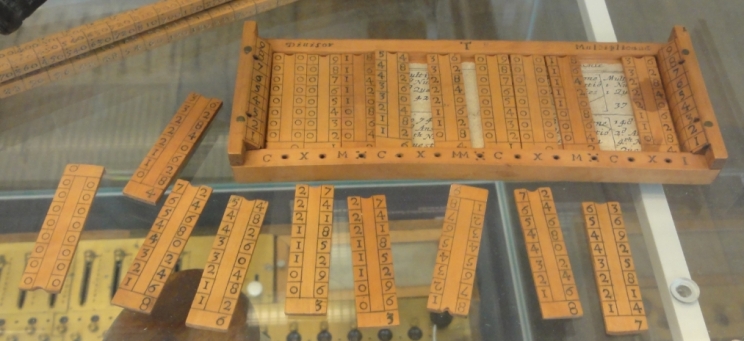Whipple Museum of the History of Science (I)

Photography by Carlos Dorce
The Whipple is a University of Cambridge museum within the Department of History and Philosophy of Science. During the 1930s and 1940s, there were strong initiatives to establish history of science within the University and an exhibition of the historical scientific apparatus owned by various colleges was held in 1936. Soon after, a History of Science Lectures Comittee was established which, together with the Cambridge Philosophical Society, negotiated in 1944 a donation of antique scientific instruments and rare books from Robert Stewart Whipple (1871-1953), former Director of the Cambridge Scientific Instrument Company.
So, let’s start our visit in the main room:

Photography by Carlos Dorce
The astronomical objects are very usual in this kind of museums and here you have a Newtonian “Herschdel Telescope” (c.1790) which was presented by George III to the Duke of Marlborough and it was placed in the Observatory at Blenheim Palace until it was given to Herschel’s great-grandson, Mr. Joseph A. Hardcastle (1816-1911).

Photography by Carlos Dorce
Sir William Herschel achieved public acclaim and royal favour through his discovery of the planet Uranus, which he originally called Georgium Sidus, to honour King George III in 1781. A few years later George III requested that he make a number of telescopes. This is one of five 10-ft reflecting telescopes made in response to that request. Following Herschel’s standard design, the King’s cabinet-maker constructed the mahogany stand and tube. Herschdel made the optical parts himself.
There also are polyhedral sundials, more telescopes, astrolabes,…

Photography by Carlos Dorce
… and this wonderful planetarium made by George Adams around 1750.

Photography by Carlos Dorce
This grand Orrery, which is not to scale, displays the Sun in the centre, and the 6 then known planets and their satellites; 4 around Jupiter and 5 around Saturn. The planets Uranus, Neptune and Pluto had not yet been discovered.
Now, let’s teke a look at the collection of astrolabes and sundials but… it will be done in the next post!
Location: Whipple Museum of the History of Science in Cambridge (map)
Mesopotamian Mathematics in the BM

Photography by Carlos Dorce
This is the famous Royal Game of Ur (2600-2300 BC). This wooden game board was in at least six graves in the Royal Cemetery so it’s an early example of a game that was played all over the ancient Near East for about 3.000 years.
The game is a race for two players using dice with seven identical pieces each. All playing squares are decorated, but on later boards only the five ‘rosette’ squares are marked. […] Pieces are ‘at war’ along the central path but turn off to their own side to exit.
Playing pieces were discs of shell or lapis lazuli. The tetrahedrical dice of the game are also exhibited.
Apart of the Royal Game of Ur, the only exhibited objects which are related with Mespotamian mathematics are the Archaic and Cuneiform tablets. For example, look at this tablet containing a five day ration list (Jemdet Nasr, 3000-2900 BC):

Photography by Carlos Dorce
Each line contains rations for one day and the sign for ‘day’ and numbers 1, 2, 3, 4 and 5 are easily identificable (at the beginning of the line!).

Photography by Carlos Dorce
This Gypsum tablet with Archaic numbers (Uruk, 3300 BC) has 3 units (round impressions) and 3 ‘tens’ (elongated impressions).
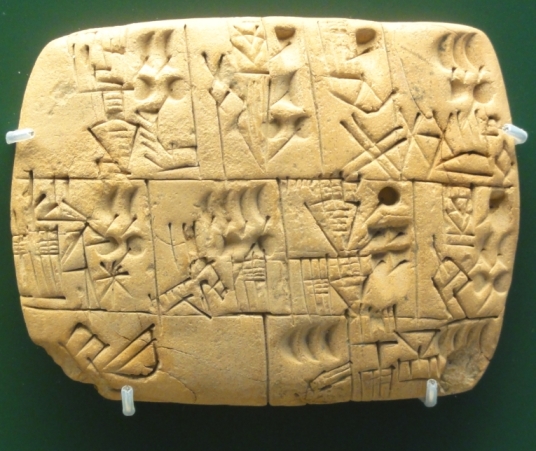
Photography by Carlos Dorce
This tablet above contains the daily barley beer ration for the workers (3300-3100 BC). Here there are also identificable all the marks representing units and tens and it’s the same in the next tablet containig food rations (3300-3100 BC):

Photography by Carlos Dorce
Finally, there is another tablet from the Late Uruk Period (3300-3100 BC):

Photography by Carlos Dorce
However, mathematical tables are not only clay tablets with figures and numbers. For example, the next tablet contains a set of problems relating to the calculation of volume, together with the solutions.

Photography by Carlos Dorce
You can see the details of the tablet in the next two pictures:

Photography by Carlos Dorce
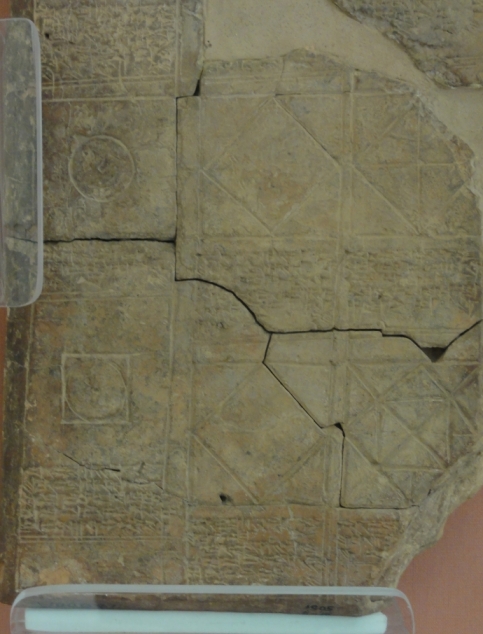
Photography by Carlos Dorce
There is also a tablet recording observations of the planet Venus from c.1700 BC:

Photography by Carlos Dorce
Astronomical tablets were so common in Mesopotamia and here we have a representation of the heavens in eight segments which include drawings of the constellations.

Photography by Carlos Dorce
The next piece of cuneiform tablet contains a star chart which was found in Ashurbanipal’s library:

Photography by Carlos Dorce
According the British Museum’s web…
Ashurbanipal, whose name (Ashur-bani-apli) means, ‘the god Ashur is the creator of the heir’, came to the Assyrian throne in 668 BC. He continued to live in the Southwest Palace of his grandfather, Sennacherib, in Nineveh, which he decorated with wall reliefs depicting his military activity in Elam. He also had a new residence built at Nineveh, known today as the North Palace. The famous lion hunt reliefs, some of which are now in The British Museum, formed part of the new palace’s decorative scheme.
Throughout his reign, Ashurbanipal had military problems, mainly at the borders of the empire. He also continued his father’s policy of attacking Egypt. Campaigns in 667 and 664 BC led to the defeat of the Egyptian Twenty-fifth Dynasty and the appointment of a pro-Assyrian ruler in the Nile Delta. Assyria also attacked Elam, possibly in 658-57 BC, following the receipt of insulting letters from the Elamite king. In 652 BC Shamash-shum-ukin, Ashurbanipal’s brother, and ruler of Babylonia, revolted against Assyria with the support of the Elamites. The Assyrian army invaded Elam and Babylonia. Babylon was captured in 648 BC and the following year the Elamite city of Susa was destroyed. There is little surviving evidence that can help us to reconstruct the last years of Ashurbanipal’s reign. Ashurbanipal boasted of his ability to read the cuneiform script, and was responsible for the collection and copying of a major library of contemporary literary and religious texts
Location: British Museum in London (map)
The Science Museum in London (VI)

Photography by Carlos Dorce
Let’s play with Topology! The exhibition is full of polyhedra, curious surfaces,… and Möbius strips:

Photography by Carlos Dorce
August Möbius (1790-1868)
Professor Möbius discovered the surface now known as the Möbius strip in the course of an investigation of the properties of polyhedra. The discovery was made in 1858 but was not published until 1865.
There is certainly also the Klein’s bottle:

Photography by Carlos Dorce
We can imagine what a wonderful surface we can get if a plane is deformed!

Photography by Carlos Dorce
Sometimes, it depends on our point of view and there are surfaces which are homeomorphic to other ones that seems very different to them! If we look at the example of the conics, the circumference, the ellipse, the hyperbola and the parabola are different points of view of the same reality, aren’t they?

Photography by Carlos Dorce
Location: Science Museum in London (map)
Mathematical art in Cecil Court

Photography by Carlos Dorce
This is an art shop in the beautiful Cecil Court where I notice the next picture painted by Ross.

Photography by Carlos Dorce
Does anybody know who is this “Ross”?
Location: Cecil Court in London (map)
The Museum of the History of Science (V)

Photography by Carlos Dorce
One of the curious objects of the collection is this Tamil charm with a magic square that is not dated. The copper plate carries a magic square in Tamil characters where the letters are equivalent to numbers.
We can also find these Italian engraved discs from the 17th or 18th century:

Photography by Carlos Dorce
Although the purposes of these brass discs is not fully known, the were probably magical. [The left one] is engraved with a solar calendar, the signs of the zodiac, and the names of the angels supposed to govern them. [The other disc] has a representation of the Aristotelian cosmos.
And this is the Monument to Mathematics:

Photography by Carlos Dorce
This alabaster sculpture illustrates the regular polyhedra and it was presented to the Bodleian Library in 1620 by Sir Clement Edmonds, Fellow of All Souls:

Photography by Carlos Dorce

Photography by Carlos Dorce
Location: The Museum of the History of Science (map)
The Museum of the History of Science (IV)

Photography by Carlos Dorce
This is a horary quadrant by the famous engraver Henry Sutton (London, 1658) is for finding the time from the altitude of the sun and it’s behind this other ivory quadrant that follows the design published in 1623 by Edmund Gunter:
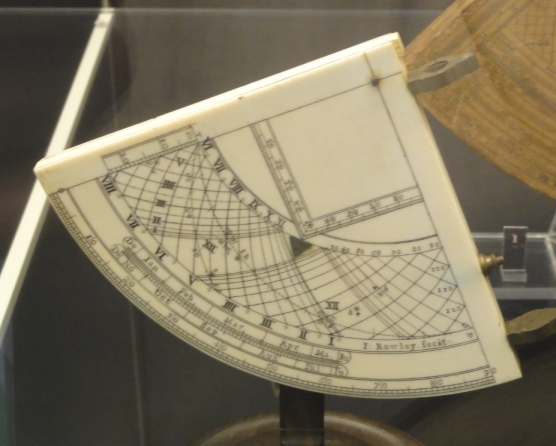
Photography by Carlos Dorce
Look at this French globe with a German sundial:

Photography by Carlos Dorce
As the globe is driven by an internal clock movement, time is indicated by the fixed pointed on one side. This 16th-century French clock is now surmounted by a ‘scaphe’ sundial by Ulrich Schniep, who worked in Munich. The dial is dated in 1555.
Another beautiful object of the collection is this Copernican armillay sphere (london, c.1700) made in silver and ebonyin which it’s possible notice the Sun in the middle of the Universe:

Photography by Carlos Dorce
A lot of astronomical instruments were made by very important engravers and in the collection we can find the instrument with which it was possible making sundials:

Photography by Carlos Dorce
This is an instrument for drawing sundials (London, c.1700), and there is a contemporany manuscript, possibly written by the maker John Rowley, which describes its use. The three bands represent the meridian, the equinoctial and the horizon, while the thin plate, which tilts and rotates within the horizon band, represents the plane of inclination of the dial to be drawn. Using a candle and a line, shadows can be cast on to the plate for successive positions of the Sun.
Apart from the typical sundials, there also are very beautiful pieces like this one made by Paul Reinmann from the Nuremberg workshops.
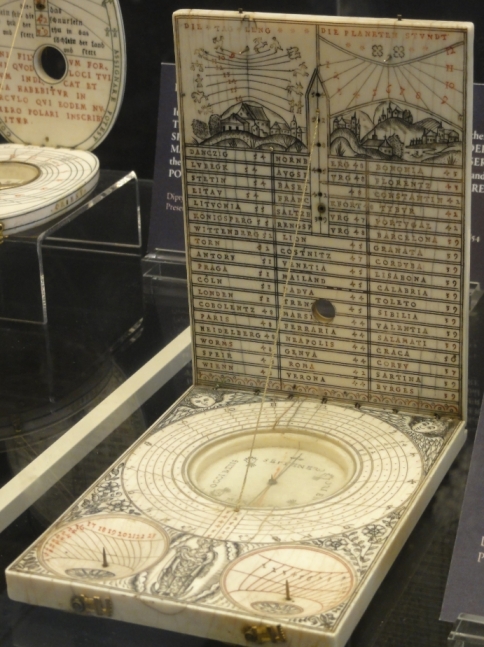
Photography by Carlos Dorce
…or this other French polyhedrical sundial:
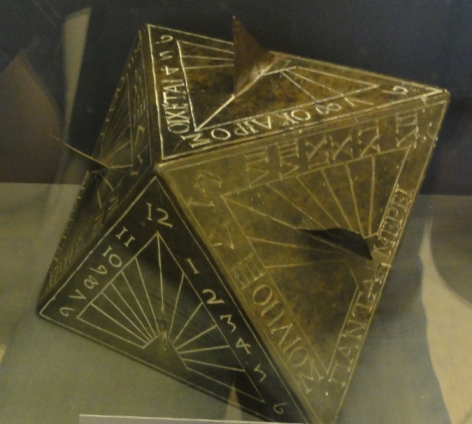
Photography by Carlos Dorce
The polyhedrical dials are very typical in the History of Astronomy and here we can see some examples of this:

Photography by Carlos Dorce
Used most often for outdoor instruments such as monumental garden sundials, stone was occasionally employed for portable instruments. Honestone and Solenhofen stone gave particularly smooth surface.
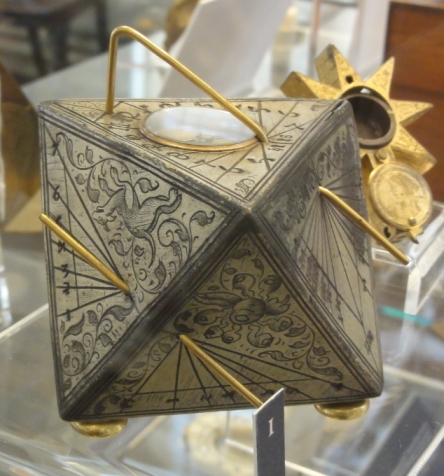
Photography by Carlos Dorce
Location: The Museum of the History of Science (map)
The wonderful vault in Wells

Photography by Carlos Dorce
Today I’ve seen this picture taken in the cathedral of Wells. It’s a typical vault in the English Cathedrals and it’s impossible to say that it’s a very mathematical image, isn’t it?
Fiona Banner Full Stop Courier 2003
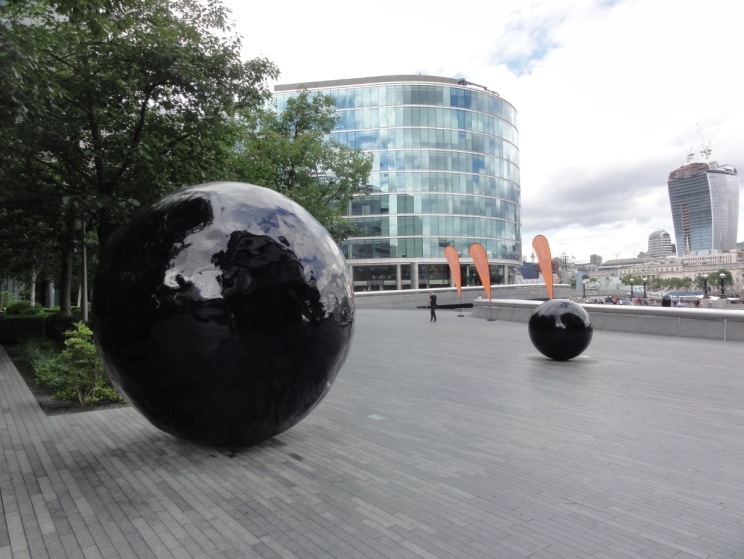
Photography by Carlos Dorce
Today has been our last day in London and we’ve decided to go for a walk along the Thames and we’ve discovered this set of ‘mathematical’ sculptures. Probably they aren’t too important but I’ve liked a lot.

Photography by Carlos Dorce
Location: map
Nicholas Kratzer (1487? – 1550)

Nicholas Kratzer, 1528 painting after Hans Holbein the Younger
National Portrait Gallery (London)
Nicholas Kratzer was born in Munich and arrived in England in 1516. He became member of the scientific circle around Sir Thomas More (1478-1535) from tutoring More’s children in astronomy and mathematics. After being introduced at Henry VIII’s court (Kratzer was appointed the royal astronomer in 1520), he became friend of important painters as Hans Holbein the Younger and Albrecht Dürer.
In this portrait painted by Holbein, he is surrounded by some astronomical instruments as a sundial or a quadrant and we can see how Kratzer was engraving a polyhedrical sundial.
Location: National Portrait Gallery (map)






